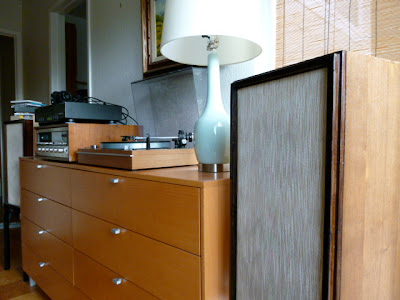 A running theme of this blog has been the superiority of vinyl music reproduction to current digital music formats. I'm convinced that it's not an exercise in nostalgia, where one clings to an outdated inferior technology for sentimental reasons. Well, there's the nostalgia, too. But there's no doubt that vinyl records just sound better. The market has abandoned records and turntables for other reasons--lack of convenience, better profits in digital music (ironically that didn't work out as it opened the pirating floodgates), and just a general tendency of the market to push and the public to adopt the new, new thing.
A running theme of this blog has been the superiority of vinyl music reproduction to current digital music formats. I'm convinced that it's not an exercise in nostalgia, where one clings to an outdated inferior technology for sentimental reasons. Well, there's the nostalgia, too. But there's no doubt that vinyl records just sound better. The market has abandoned records and turntables for other reasons--lack of convenience, better profits in digital music (ironically that didn't work out as it opened the pirating floodgates), and just a general tendency of the market to push and the public to adopt the new, new thing.Sunday, February 26, 2012
Slightly Off Topic: Polaroids
 A running theme of this blog has been the superiority of vinyl music reproduction to current digital music formats. I'm convinced that it's not an exercise in nostalgia, where one clings to an outdated inferior technology for sentimental reasons. Well, there's the nostalgia, too. But there's no doubt that vinyl records just sound better. The market has abandoned records and turntables for other reasons--lack of convenience, better profits in digital music (ironically that didn't work out as it opened the pirating floodgates), and just a general tendency of the market to push and the public to adopt the new, new thing.
A running theme of this blog has been the superiority of vinyl music reproduction to current digital music formats. I'm convinced that it's not an exercise in nostalgia, where one clings to an outdated inferior technology for sentimental reasons. Well, there's the nostalgia, too. But there's no doubt that vinyl records just sound better. The market has abandoned records and turntables for other reasons--lack of convenience, better profits in digital music (ironically that didn't work out as it opened the pirating floodgates), and just a general tendency of the market to push and the public to adopt the new, new thing.Monday, February 20, 2012
Going Vintage: Salvaging the 70s

Only if CD Players were made in the 60s and 70s. My California Audio Labs cd player looks plain-janey on top of the Marantz receiver. Grado SR-80 head-phones (shown on top) always had a retro look.
Sunday, February 5, 2012
Chance Discovery: Clyde McCoy
Friday, February 3, 2012
Snobs vs. Connoisseurs

Is there such a thing as perfect taste? No. Taste just comes down to preferences. It makes no sense to claim one has perfect preferences. That’s my definition of a snob—a person who believes his taste is superior to others and by inference he is better than others. Snobs are insufferable. Contrast that to someone who can discern and appreciate quality based on knowledge. I call this person a connoisseur.
Let’s consider audio speakers to illustrate the distinction. There are people who think Bose speakers are high quality, high fidelity speakers. Bose speakers obviously are not. Even the most expensive Bose speakers have bloated, undefined bass, can’t convincingly reproduce a coherent soundstage, and can’t convey dynamic subtleties in the recording. I’m not being a snob, because I’ve heard speakers that reproduce music much better than Bose speakers. The people who think Bose speakers are great, I believe, fall for the superior marketing of the company and haven’t been exposed to true high fidelity speakers.
Sonus Faber is an Italian speaker manufacturer that makes speakers that range in price from a couple thousand dollars to tens of thousand dollars. Their speakers do everything right that Bose speakers don’t. However, I don’t like Sonus Faber speakers. They have a sonic character that I find is a little too lush and dark for my taste. SF speakers don’t distort the music, but they definitely have a certain sound (just as some musicians say an Amati violin sound different from a Stradivarius. Both violins produce correct notes, but have slightly different sonic character.) I ended up buying German-made Audio Physic speakers after auditioning them next to Sonus Faber speakers. At this level, it would be ridiculous to claim AP speakers are superior to SF speakers. It’s only a personal preference. People who are willing to make the claim of the superiority of one brand over the other cross the line from being a connoisseur to being a snob.


